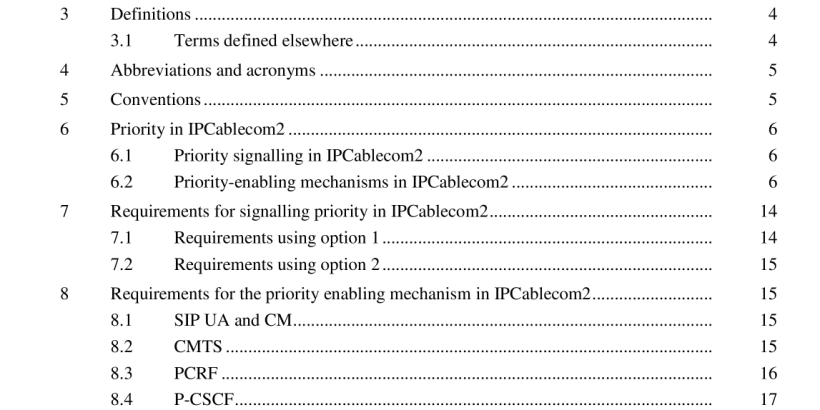ANSI SCTE 173-4-2017 pdf download.Specification for Priority in Preferential Telecommunications over IPCablecom2 Networks
6.1 Priority signalling in IPCablecom2
The framework identifies the use of Resource-Priority and Accept-Resource-Priority headers defined in [IETF RFC 4412] to signal the priority in SIP request and response messages. [IETF RFC 4412] defines the term RP actor. This term refers to all entities that act upon the Resource-Priority header. These entities are the SIP proxies and the SIP user agents (UAs). In IPCablecom2, the SIP proxies are collectively called CSCF (call session control function). The UAs are the end points that initiate and receive a session: they are respectively the SIP UAC (user agent client) and SIP UAS (user agent server). These will both be referred to as the SIP UA. There are two options for handling the R-P header. In the first option, the SIP UA shall include the R-P header, as described in section 4.7.1 of [IETF RFC 4412], in the request messages when requesting sessions in support of preferential telecommunication services. In the second option, a proxy CSCF shall generate and insert an appropriate R-P header based upon the information received in the session set-up request. The requirements to be supported by the functional entities in IPCablecom2 networks are included in clause 7.
6.2 Priority-enabling mechanisms in IPCablecom2
Appendix II of [b-ITU-T J.360] and [ANSI/SCTE 159-1] define interfaces to set up policies and control for enabling QoS to support resource management for new services, including those that require preferential treatment. Even though QoS is not meant to imply priority, one of the considerations for the QoS architecture in IPCablecom2 networks is prioritization for sessions. [ANSI/SCTE 159-1]-specified COPS interfaces between the application manager, the policy server and CMTS may be used to perform resource management and admission control. Expanding on the COPS-defined objects, a new object called GateSpec is defined. The GateSpec object specifies a session class ID with several subfields to set priority and enable preemption of lower priority services if necessary (and allowed). The session class ID has bits 0-2 with priority values between 0 (lowest) to 7 (highest). This Standard does not assign values for the services that require preferential treatment. It is, therefore, necessary for users and service providers to assign the values associated with the different services. The enabling of prioritization in IPCablecom2 networks is composed of two components. The first is at the data link layer and involves making DOCSIS service flows more promptly available for gates of a certain session class. The second is at the session layer and involves describing the priority status of a call so that the information can be propagated to all relevant entities in the network. [ANSI/SCTE 159-1] defines the process for associating the gates to the service flows.
Depending on the two options discussed in clause 6.1 relative to where the R-P header is inserted, the service flow is set up by the CMTS without requiring any gates to be set up by the PCRF. In option 1, the CM may request service flows (downstream and upstream) be set up with traffic priority for preferential services, based on a configuration file. The CM sends the INVITE in this service flow instead of in the primary service flow, as in option 2. The CMTS, based on the R-P header priority, can offer requests for additional bandwidth and contention request opportunities when congestion may prevent the CM from sending requests through to CMTS for upstream traffic. Option 1 may, in addition, use the exchanges to set up gates, as in option 2, for resource management and admission control.ANSI SCTE 173-4-2017 pdf download
